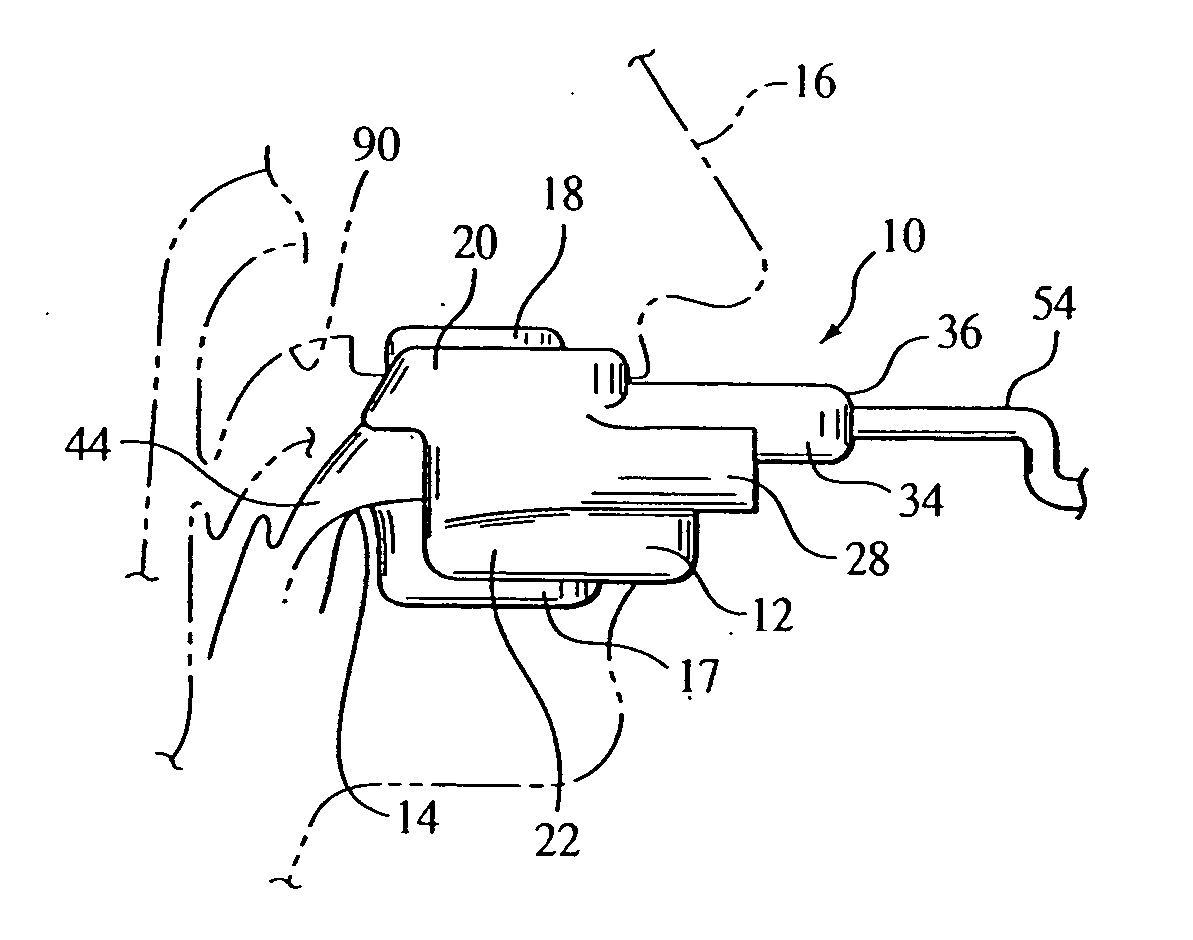Intraoral apparatus for enhancing airway patency
a technology of airway patency and intraoral apparatus, which is applied in the direction of dental surgery, snoring prevention, teeth capping, etc., to achieve the effects of enhancing upper airway patency, effective treatment, and enhancing upper airway stability
- Summary
- Abstract
- Description
- Claims
- Application Information
AI Technical Summary
Benefits of technology
Problems solved by technology
Method used
Image
Examples
second embodiment
[0051] In the invention described thus far, the user's mandible structure (lower dentition) and tongue are positioned and retained forwardly of their relaxed or neutral positions. If only tongue positioning is required, the apparatus of FIG. 4 need not include the lower dentition receiving tray 22, because the apparatus can be anchored to the upper dentition alone. FIG. 5 illustrates an intraoral appliance 70 having such a configuration according to the invention. Intraoral appliance 70 also illustrates an alternative embodiment for a connecting assembly, generally indicated at 72, that is used to control the position of tongue receiving sleeve 40 relative to a body 74 of the appliance. The connecting assembly shown in FIG. 5 can be used in the other embodiments of the present invention.
[0052] In the embodiment shown in FIG. 5, a threaded protruding element 76 is coupled to tongue retaining sleeve 40 and a threaded tab 78 is coupled to body 74. The relative positional relationship o...
third embodiment
[0055] As has been noted, the invention contemplates the selective positioning of various anatomic features associated with the upper airway, including intraoral and pharyngeal features, in a manner to alleviate the incidence of airway obstruction associated with OSA, hypopnea, UARS and other conditions. Accordingly, the invention shown in FIGS. 8 and 9 provides a soft palate engaging element 80, such as a suction cup or similar element, for controlling the position of the user's soft palate to treat the breathing disorder. The present invention contemplates providing soft palate engaging element 80 in addition to or in place of tongue retaining sleeve 40 in the intraoral appliance of FIGS. 1-5 so that either the tongue position controlling feature, the soft palate position controlling feature, or both can be accomplished by the intraoral appliance of the present invention. The same connecting assembly that is used to attach the tongue retaining sleeve to the body of the intraoral a...
fourth embodiment
[0058] In the embodiments described above, and, more specifically, in the embodiment described above with respect to FIGS. 1-4, the user's upper and lower dentitions are maintained in a fixed position relative to one another and cannot be altered or changed. The present invention, however, contemplates selectively adjusting the relative positions of the upper and lower dentitions, either for patient comfort or for additional therapeutic benefits. To this end, FIG. 10 illustrates an intraoral apparatus 92 having a mandibular adjustment function and structure for accomplishing same. The present invention contemplates that the mandibular adjustment feature of intraoral appliance 92 can be provided in conjunction with one or more of the following: (1) providing a positive airway pressure to the airway of the patient; (2) providing the tongue positioning function associated with the embodiment of FIGS. 1-7; and (3) providing the soft palate positioning function associated with the embodi...
PUM
 Login to View More
Login to View More Abstract
Description
Claims
Application Information
 Login to View More
Login to View More - R&D
- Intellectual Property
- Life Sciences
- Materials
- Tech Scout
- Unparalleled Data Quality
- Higher Quality Content
- 60% Fewer Hallucinations
Browse by: Latest US Patents, China's latest patents, Technical Efficacy Thesaurus, Application Domain, Technology Topic, Popular Technical Reports.
© 2025 PatSnap. All rights reserved.Legal|Privacy policy|Modern Slavery Act Transparency Statement|Sitemap|About US| Contact US: help@patsnap.com



